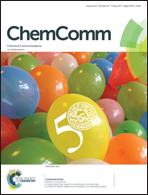[FeFe] Hydrogenase active site model chemistry in a UiO-66 metal–organic framework†
Abstract
The reactivity of [Fe2(dcbdt)(CO)6] (1) confined in a UiO-66(Zr) metal–organic framework towards CO ligand substitutions with phosphines of different sizes was investigated. The reaction with smaller phosphines (PX3, X = Me, Et) is more selective compared to analogous reactions in homogenous solution phase, and two CO ligands at up to 80% of all [FeFe] sites in UiO-66–1 are replaced. The produced [Fe2(dcbdt)(CO)4(PX3)2] complexes in the UiO-66 matrix behave like typical [FeFe] hydrogenase active site model complexes, are reduced at more cathodic potentials than their hexacarbonyl analogues, and form bridging hydrides under acidic conditions.
![Graphical abstract: [FeFe] Hydrogenase active site model chemistry in a UiO-66 metal–organic framework](/en/Image/Get?imageInfo.ImageType=GA&imageInfo.ImageIdentifier.ManuscriptID=C7CC01620D&imageInfo.ImageIdentifier.Year=2017)


 Please wait while we load your content...
Please wait while we load your content...